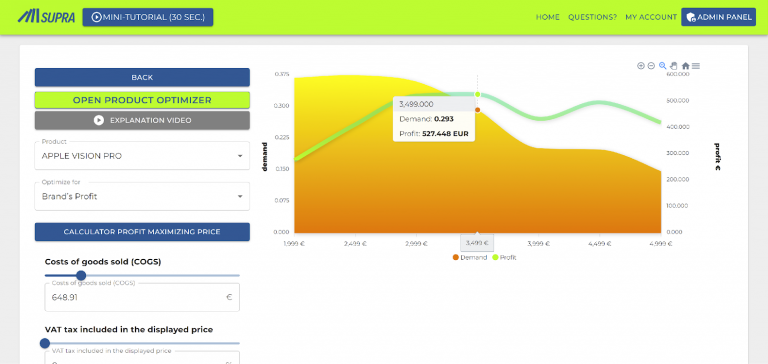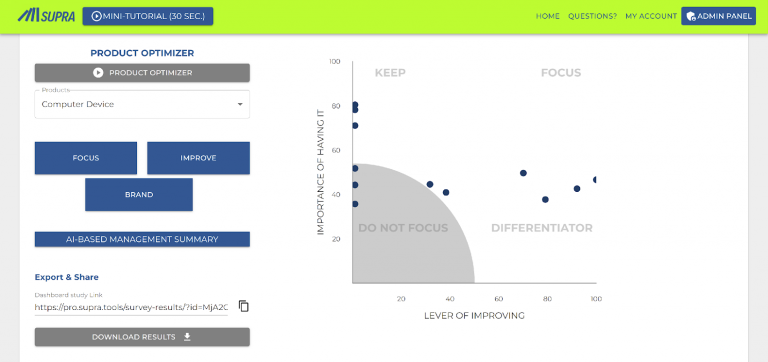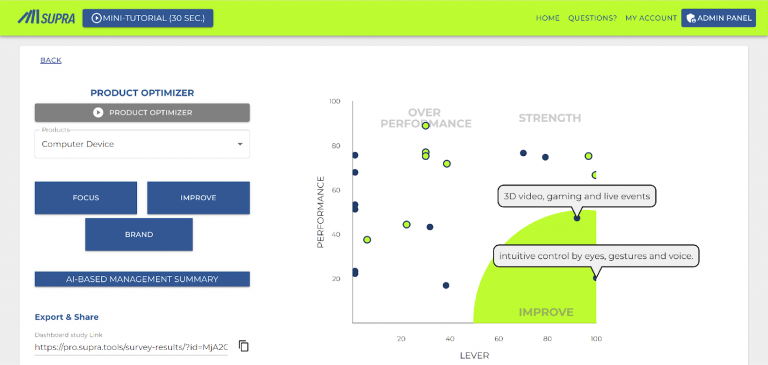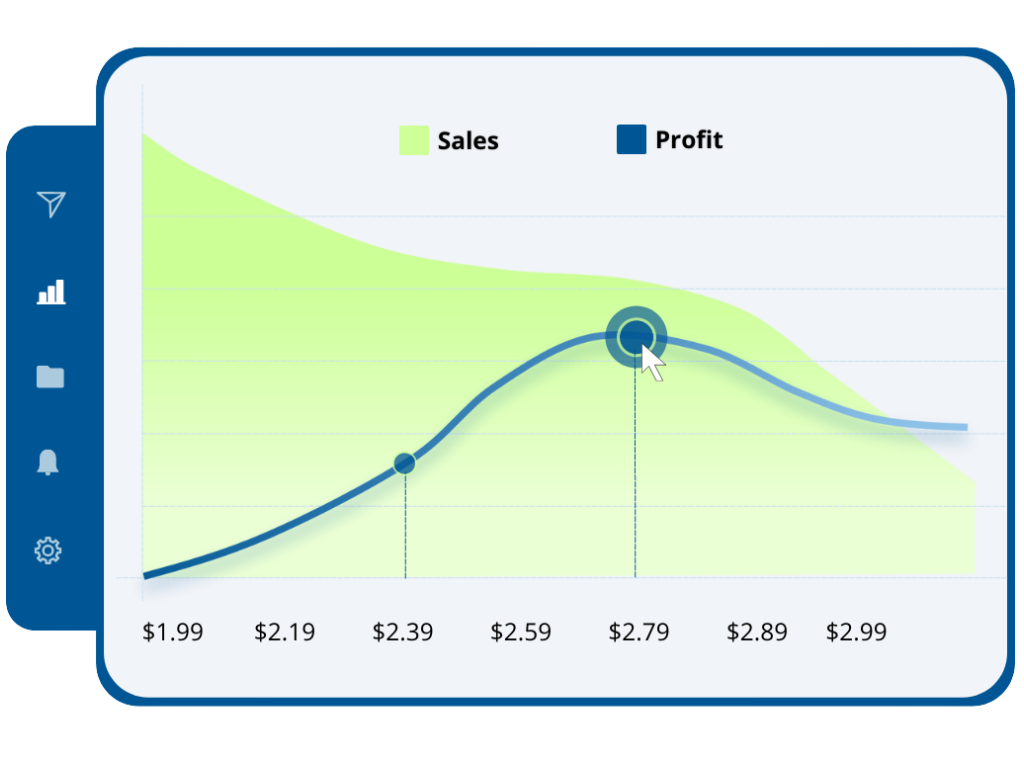April 18, 2024
Better than Conjoint?
How Implicit Intelligence Overcomes the Limitations of Conjoint

Pricing Optimizer

To inform product development, pricing, and market communications, companies need to know how well certain features and price levels encourage or discourage purchase decisions.
A year before its launch, we put the Apple Vision Pro through the Implicit Intelligence research process because it pushed the boundaries of traditional research approaches. First of all, this Apple product opens a new category and there was only one other product on the market that could be used as a reference point (Metas VR glasses) – how do you set up a conjoint with that? To make matters worse, the number of essential features to be evaluated was beyond the scope of any reasonable conjoint approach.
The feature set we tested was: spatial user interface, intuitive control by eyes, gestures and voice, Integrating physical environment with user interface, user’s eyes are visible to others, ultra-high resolution display, infinite workspace, 3D photos and videos capture, spatial video telephony, high quality case made of aluminum and glass materials, 3D video, gaming and live events, app store has many 3D games and movies, 2 hours long battery life.
There was also concern about how a simple bullet point list of features (the way conjoint displays a product) could convey well enough what the product was really about.
An international footwear brand wanted to reposition and re-price its six key products and understand the role of key features.
Here is the list of 30 features important to the marketing team: Traction, Suitable for the outdoors, Arch support, Lightweight, Popular brand, Comfortable, Craftsmanship, Water-resistant, Waterproof, Attractive design, Anti-fatigue, Easy to mix and match, Cushioned, Suitable for everyday, Suitable for a variety of occasions, Padded collar, Hand-sewn construction, Premium leather, Fits well, Warm, Premium construction, Iconic design, Suitable for hiking, Rubber Lug Outsole, Breathable, Insulated, Sustainable materials, Durable
Not only was the number of features a challenge for the conjoint, but the assumption of the set of competitive products seemed unrealistic to the team. The products are mostly sold in branded stores where there is only internal competition, while in Internet stores the competition is almost unlimited. At the very least, there is no clear, well-defined set of competitors that would realistically model a typical purchase decision.
A bank planned to change the credit cards it offers to account plans. This would change not only the features, but also the monthly card fee. It was not clear how to promote the change or how to price it. Since the prospects were their own customers, it was not easy to structure a competitive conjoint task.
In addition, the features of interest were far beyond the scope of conjoint: Accepted worldwide, Apple Pay supported, eCommerce payments, full spending control, 2-factor authentication, PIN of choice, amount reservation (e.g. in hotels), cash at HVB ATMs, fraud prevention, self-service functionality, change PIN online, Google Pay supported, virtual credit cards, app push alert instead of SMS, order blocking & limits online, sending money to friends, delayed account debit, immediate account debit
The advent of conjoint measurement introduces a major advantage. The approach structures a choice task in such a way that it becomes difficult for respondents to solve the task rationally. It forces them to use part of their gut or intuition, as in real life.
This advantage certainly disappears when the number of features is too small. If you look at typical conjoint studies, you will see that they often use only two or three features. Too often, only price and brand are used.
The original conjoint measurement from the 70’s is hardly used anymore. Mostly choice based conjoint (discrete choice modeling) is what research agencies offer. Here, too, we have a wide variety of applications. With or without non-option? Sum or Choice Based Conjoint? Limit or HB Conjoint? Conjoint requires a lot of experience, both to set it up and to analyze it properly.
The limitations of the approach have already become clear in the examples above:
MaxDiff is a survey approach that asks for preferences for all pairs of features in the feature set. Based on this, it computes an importance ranking. This approach is typically recommended when the number of features exceeds the capabilities of conjoint.
While it is a practical and useful method that complements conjoint well, it has serious limitations of its own:
95% of a purchase decision (B2C and B2B) is driven by the unconscious, implicit associations that occur within milliseconds of a product presentation. While it takes seconds to form a rational opinion, our immediate gut instinct guides how we rationally process information and what information we focus on. This also applies to price perception itself. The “gut” tells us if a price is too high or too low, regardless of what price knowledge we actually have. Unleashing this implicit association is the key to reliably estimating the price demand function as well as the perception of product features.
This is what Implicit Intelligence does. The name comes from the fact that the approach combines implicit research (a form of the Implicit Association Test – IAT) with artificial intelligence (specifically Causal AI).
This AI is used in two ways: First, it eliminates survey bias introduced by the price anchor effects of the highest and lowest price points tested. Second, the AI serves as a modern driver analysis, providing insight into the leverage that improving a feature’s perception would have.
This is the exact process of the method
Depending on the number of features, the questionnaire typically takes 7 to 10 minutes to complete. As such, it is no more demanding for respondents than conjoint questionnaires.
The implicit price acceptance test is actually an accurate measure of willingness to buy and willingness to pay (at a given price point). Causal Driver Analysis can now use this information as the ultimate target variable. It even provides seven data points and facets of purchase intent, making the whole exercise statistically very robust.
By bolding different assessment exercises such as Feature Assessment, Brand Architype Assessment, or even a Touchpoint Contact Assessment, we are able to understand the impact of features, architype, or touchpoints on the purchase decision. All in a single exercise.
The price demand function is accessible in a dashboard. With sliders, the user can make assumptions for the cost of the sold good, VAT and retail margin. With this input, the dashboard shows how the brand’s profit depends on the pricing. This allows brands to make profit maximizing pricing decisions.

The Focus View dashboard contrasts the “importance of having it” (derived from Implicit MaxDiff) with the “lever to improve it” (result of Causal AI Driver Analysis). The example here shows the various features of the Apple Vision Pro. Exciting insights here are that features like “ultra-high screen resolution” and “2h battery life” are very important, but there is no lever to improve them. It shows that there is no need to improve it, even though it is “very important”.

The Improve View dashboard shows the 12 features (blue) and the eight common barriers to innovation adoption (green) in a matrix diagram that contrasts the “lever of improvement” with the actual perception (performance) of the features. The analysis showed that the features “3D video, games and live events” and “intuitive control with eyes, gestures and voice” have a huge lever, but in reality, prospects have doubts about the product’s ability to deliver. These are the core areas that Apple needed to address in its communications efforts to make the launch a success.

What the platform does not provide is a market simulation – a feature that many conjoint software solutions offer. Such a simulation requires the evaluation of a competitive set of products.
If brands choose to run competitive products through the implicit intelligence testing process, we at Success Drivers will run a market simulation outside of this tool. If needed on a regular basis, we can implement this feature in supra.tools.
In the evolving landscape of market research, traditional conjoint analysis has long been the go-to method for product and price optimization. However, we introduce a groundbreaking approach, Implicit Intelligence, that promises to surpass the capabilities of conjoint analysis. The article discusses the limitations of conjoint analysis, such as its inability to handle large numbers of product features, provide realistic product descriptions, and accurately measure price elasticity. These limitations often lead to biased results and reduced predictive power.
Implicit Intelligence provides a solution by leveraging the subconscious, rapid associations consumers make with products. It integrates Implicit Association Testing (IAT) with Artificial Intelligence, specifically Causal AI, to overcome the biases and limitations of traditional survey methods. By capturing instinctive responses to product features and prices, it provides a more accurate reflection of consumer behavior and preferences.
The Implicit Intelligence process involves multiple steps, including detailed product introductions, assessing the importance of price and features through IAT, and controlling for external purchase drivers. This approach not only measures the absolute importance of features (unlike MaxDiff, which measures relative importance), but also allows for causal driver analysis to understand the impact of improving feature perceptions.
We also highlighted the practical applications of Implicit Intelligence, with insights from testing products such as the Apple Vision Pro. The methodology provides detailed dashboards for analyzing price demand functions, the importance and potential for feature improvement, and identifies areas for communication efforts to improve product launch success.

In my email newsletter “Pricing Insights” I cover the whole range of pricing insights solutions-from Garbor Granger to Conjoint, from NeuroPricing to Pricing Software Systems. I describe the application in various fields from new product pricing to promotion, from brand premium to feature pricing.
Keep up to date here.